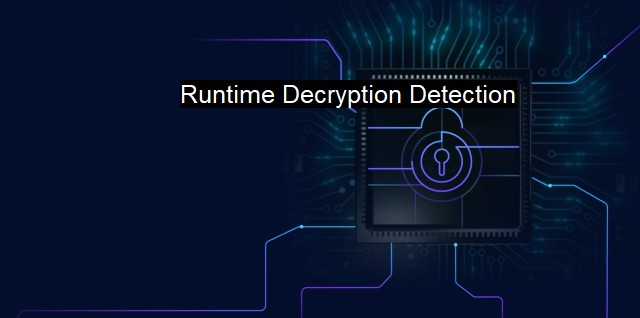What is Runtime Decryption Detection?
Enhancing Cybersecurity: Detecting Complex Malware with Runtime Decryption Detection (RDD)
Developers employ multiple defense strategies to shield various systems and networks from cyber threats. One such strategy is "Runtime Decryption Detection," which is a technique used in advanced and modernized antivirus programs and cybersecurity solutions. This technique helps enhance the protective strength of these solutions against malicious intruders trying to exploit vulnerabilities present within software systems.Runtime Decryption Detection is a technology designed to identify and neutralize malicious software exerting efforts to overreach system defenses through evasive encryption and decryption processes. understanding this technique first necessitates getting a grasp on the notions of encryption and decryption.
Encryption is the practice of converting information or data into an unreadable code to prevent unauthorized people from accessing it. Conversely, decryption refers to the process of converting encrypted data back into its original form—making it readable and understandable again. Malicious software or malware often uses these twin methods to evade detection by antivirus programs during runtime, making these threats harder to catch and neutralize.
When it comes to runtime, it is the phase during which a program or software is active or in operation. In the context of cybersecurity threats, runtime is when malicious programs, once activated by the user, start deploying their harmful operations. Unfortunately, some of these malware tools are designed to utilize encryption and decryption techniques during runtime to avoid detection.
This evasion tactic is where the essence of Runtime Decryption Detection becomes more pronounced. Through this technology, antivirus programs and cybersecurity solutions keep a close watch on applications and their behaviors at runtime. These solutions continuously analyze the application activity, attempting to spot abnormal or suspiciously high encryption and decryption activities.
If an application exhibits an unusual or irregular pattern of encryption-decryption, it is flagged as potentially harmful. Once flagged, the antivirus program can isolate the flagged item before it poses any serious harm to the system and then neutralize it—be it by removing or repairing the potentially malignant code.
The primary advantage of Runtime Decryption Detection is its proactivity in identifying concealed cybersecurity threats that would go unnoticed without this layer of protection. By nipping these threats in the bud during runtime, it considerably minimizes the operational window of malware, disrupting their routines, and preserving the integrity, confidentiality, and availability of the system's data.
While the technology provides enhanced protection against cybersecurity threats, it also has its set of challenges. First, it varies in effectiveness between systems and software, and may not provide comprehensive protection against all threats. It also requires significant system resources and a high level of expertise to be implemented successfully. Despite these challenges, Runtime Decryption Detection is still a critical tool in our security defenses against nefarious elements perpetually prowling within the cybersecurity landscape.
Runtime Decryption Detection is an advanced, formidable tool in antivirus programs and cybersecurity solutions. It boosts their ability to detect malicious decryption activities during the runtime of applications, proving essential in curbing modern malware threats that use concealment techniques to dodge system defenses. The complexity and inventiveness of the constantly evolving cybersecurity threats challenge us to keep refining this technique and strengthening our other defense lines. Thus, investing time, effort, and resources in researching, improving, and mastering Runtime Decryption Detection works to maintain and preserve system security, eventually leading to a safer digital world.

Runtime Decryption Detection FAQs
What is runtime decryption detection?
Runtime decryption detection is a cybersecurity mechanism that identifies and prevents malware from decrypting itself during runtime. This technique is used by antivirus software to detect and stop malicious programs that use encryption to hide their activities.How does runtime decryption detection work?
Runtime decryption detection works by monitoring the system’s memory for any suspicious activities using decryption mechanisms. If it detects any such activities, it triggers an alert, and the antivirus software takes necessary actions to quarantine or remove the malware.Why is runtime decryption detection important?
Runtime decryption detection is essential for cybersecurity because many malware programs use encryption techniques to evade detection by antivirus software. By detecting and blocking runtime decryption activities, this mechanism can prevent malware from executing and causing damage to the system.What are the limitations of runtime decryption detection?
While runtime decryption detection is a valuable tool in the fight against malware, it has its limitations. For example, if the malware uses sophisticated encryption techniques, it may be challenging to detect its decryption activities. Moreover, runtime decryption detection may also generate false positives, which can affect the system’s performance or lead to unnecessary alarms. Hence, it should be used in conjunction with other security measures to provide optimal protection against malware.| | A | | | B | | | C | | | D | | | E | | | F | | | G | | | H | | | I | | | J | | | K | | | L | | | M | |
| | N | | | O | | | P | | | Q | | | R | | | S | | | T | | | U | | | V | | | W | | | X | | | Y | | | Z | |
| | 1 | | | 2 | | | 3 | | | 4 | | | 7 | | | 8 | | |||||||